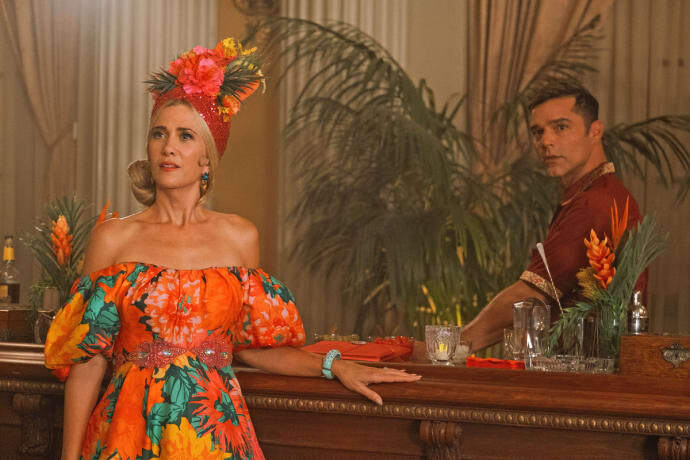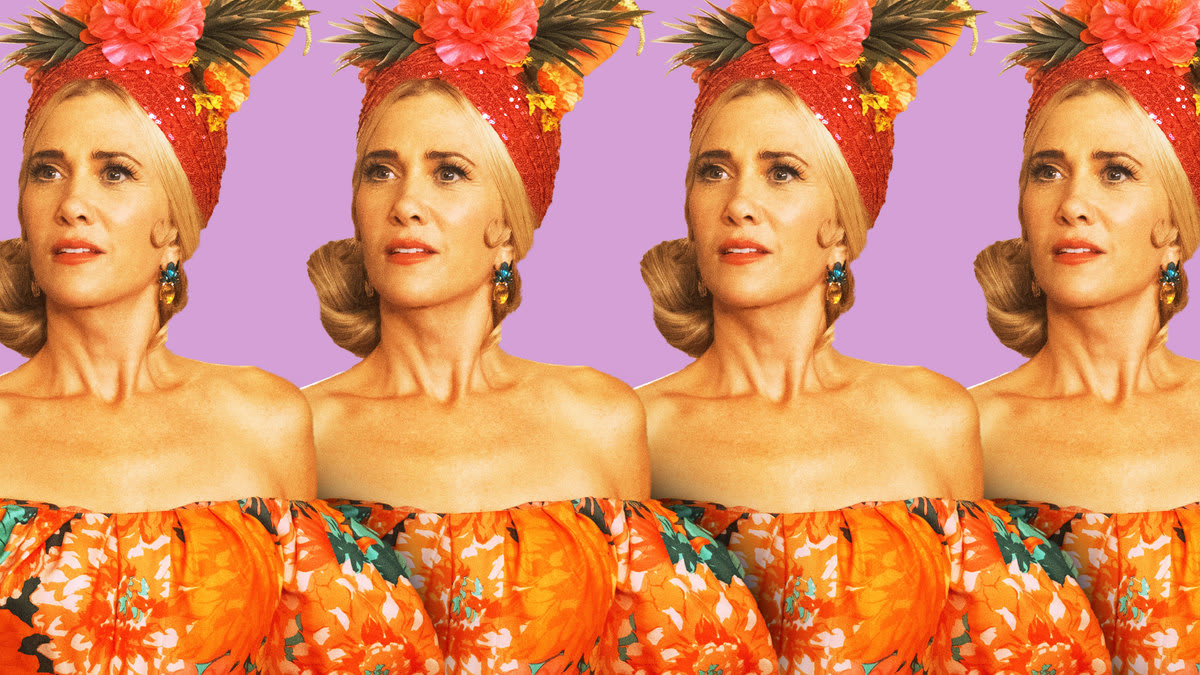Each Palm Royale episode, streaming weekly on Wednesdays on Apple TV+, presents a visual spectacle, showcasing vibrant cocktails, lavish interiors, and extravagant gowns in hues and materials that enthrall viewers.
Set in the upscale Palm Beach of 1969, these elements alone could suffice as ample eye candy. However, when planning the fourth episode titled “Maxine Rolls The Dice,” showrunner Abe Sylvia and choreographer Brooke Lipton pondered, “What if we went even bigger?”
The outcome of this maximalist approach is a jubilantly excessive 15-minute spectacle at a fundraising gala, boasting 14 showgirls, a plethora of background dancers, and numerous partner swaps during an extensive rhumba sequence.
This lavish scene not only dazzles with its visual splendor but also propels the intricate plot forward, in which the main character, Maxine Dellacorte (portrayed by Kristen Wiig), traverses through increasingly convoluted circumstances.
The fourth episode marks the midpoint of the series, where Maxine’s crash course in the country club politics of Palm Beach’s affluent elite yields both successes and revelations about her naiveté.

Palm Royale (Credits: The Daily Beast)
As she vies for status among the social elite, Maxine strategically garners support for her membership application at the exclusive Palm Royale. However, she soon finds herself in another dilemma: assuming the role of conservator for her wealthy yet comatose aunt-in-law, Norma (played by Carol Burnett), while grappling with the financial strain of mandatory and dubious fundraising events, all leading up to the grandest party of the year co-hosted with Evelyn Rollins (played by Allison Janney).
Maxine’s clumsy yet determined presence on the dance floor, maneuvering through partner changes, hushed threats, and shared secrets, symbolizes her precarious balancing act.
Every detail of the Havana Nights-themed gala exudes vibrancy and motion, with Maxine’s flamboyant floral headdress threatening to plunge her into the pool as she traverses across the ballroom’s bridge. Meanwhile, the entrance of the showgirls, adorned in sequins, satin, and feathers, accompanied by a crescendo in music, enraptures attention.
Amidst this whirlwind, Robert (played by Ricky Martin) seduces Raquel (played by Claudia Ferri) while subtly maneuvering to retrieve a necklace rightfully belonging to Norma. Even in quieter moments, such as Evelyn’s cutting remarks delivered from a balcony, the scene’s momentum remains intact, thanks to the multitude of background dancers adding depth to the setting.
Sylvia and Lipton, in an interview with The Daily Beast’s Obsessed, dissected the intricate process of orchestrating this extravaganza. Sylvia, drawing from his background in musical theater, envisioned the gala as an opportunity for frenetic farce set against the backdrop of a rhumba. The decision to incorporate multiple partner swaps offered a fresh narrative dynamic, intertwining the characters’ stories in unexpected ways.
The realization of this maximalist vision required meticulous planning and execution. Sylvia’s insistence on creating distinctively Palm Royale scenes guided the selection of the opulent Biltmore Hotel in Los Angeles as the shooting location. Lipton’s expertise in choreographing for television ensured that each moment brimmed with energy and grandeur, with professional dancers enhancing the visual spectacle.
The integration of choreography with dialogue posed a challenge, which Lipton adeptly addressed through iterative rehearsal processes, prioritizing the actors’ comedic timing. Wiig’s spontaneous approach to learning choreography on set added authenticity to her performance, a quality Sylvia attributes to her remarkable talent.
Julia Duffy’s portrayal of the eccentric Mary Davidsoul elevates the comedic intensity of the gala scene, with her dance alongside Maxine emerging as a memorable highlight. Abe Sylvia’s tribute to queer filmmaking traditions, characterized by sincerity and emotional depth, enriches the series’ thematic complexity. Kristen Wiig’s portrayal of Maxine, adeptly blending humor with vulnerability, embodies this nuanced balance, engaging audiences with her multifaceted performance.
In essence, Palm Royale transcends mere campiness by drawing from a diverse array of influences to construct a distinctive aesthetic. Sylvia’s profound respect for the emotional authenticity of his characters infuses the series with depth amidst its vibrant visuals and intricate storylines. With Wiig leading the ensemble, seamlessly blending comedy and pathos, Palm Royale promises an immersive journey through the opulent and tumultuous realm of Palm Beach’s upper echelon.























